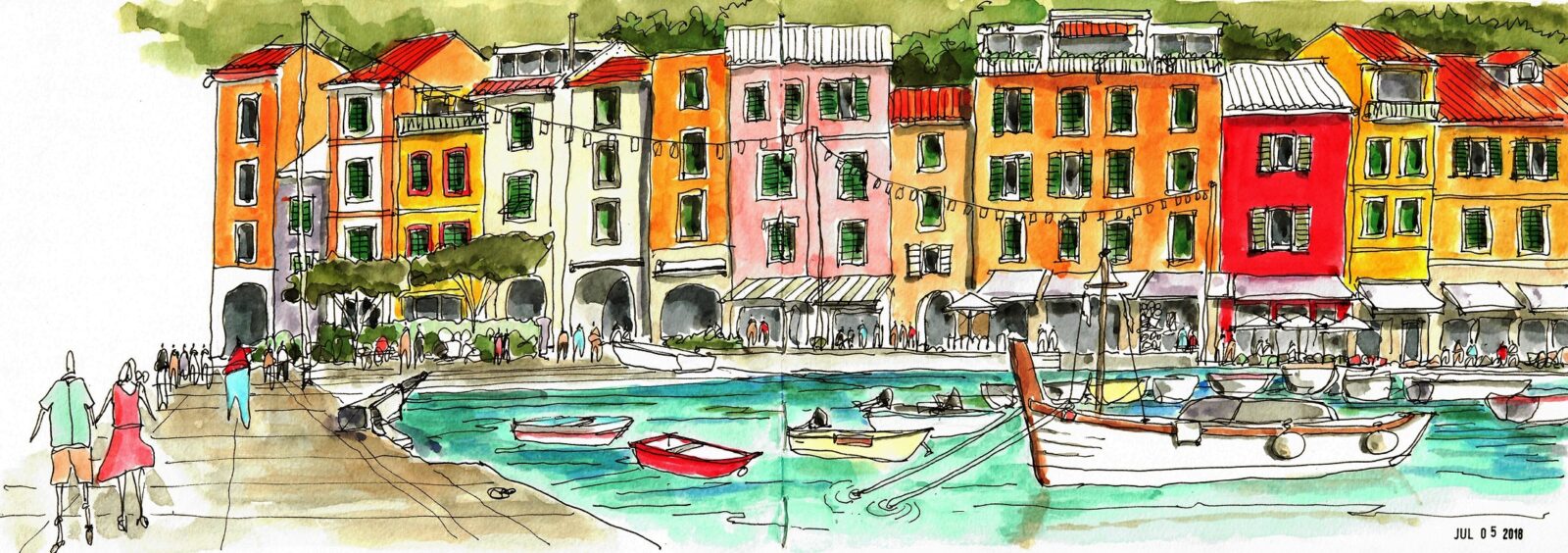I’m Architect Mike McSwain, and I Draw Pictures
Keeping drawing alive in a time of computer graphics
Published: June 1, 2020
Last Updated: September 1, 2020

Mike McSwain
Drawing of Portofino as seen from Delfino, Liguria, Italy.
Council (SRAC) and McSwain look forward to partnering in 2021 to show just how many pictures he draws during an exhibition at artspace in downtown Shreveport featuring McSwain’s sketches of well-known buildings throughout Shreveport and around the world.
When McSwain says he draws pictures, that might be an understatement. He has sketched virtually every historic building, eatery, or event in Shreveport and Bossier City, as well as recorded places and memories from his travels around the world. His sketches make up a diary of sorts—a record of his discoveries. McSwain captured SRAC’s Rainbow City installation in The Common Park when it filled the Shreveport skyline with almost forty air-filled sculptures last December. He has drawn famous architect Edward F. Nield’s Municipal Auditorium in Shreveport, where Elvis first “left the building” after a night with the Louisiana Hayride, and he has recorded Air Force events at the home of the 2nd Bomb Wing, the “Mighty Deuce,” at Barksdale Air Force Base. These drawings and many more, along with an experiential piece that will give viewers the opportunity to see, smell, and hear the specifics of a place and time, will fill Mainspace in artspace during this summer exhibition.
“My hope is that this exhibit will generate a bit of nostalgia in people, as well as provoke a renewed excitement to rediscover some familiar places which they may not have explored in a while,” said McSwain. “I love to travel, and I want to show that you don’t have to travel abroad to reap the benefits of the overall experience,” he added.
McSwain describes the planned experiential piece of the exhibition as “an interior, iconic restaurant (dive) sketch enlarged to life size, then built in separated layers that allow the user to meander in and out of the sketch and really be a part of the art.” In McSwain’s experience, the visitor both becomes part of the art and animates the art. A large sketch making up the backdrop would be a video wall that animates the waitresses, chefs, diners, and others in the background of the sketch, and ambient restaurant sounds enhance the visceral connection of being present.
McSwain’s drawings are all examples of the ways he captures experiences. They are reminders of the ideas that caused him to record the place or event in the first place—what inspired the visceral connections to the thought processes. They are something that a computer could not replicate. He draws in watercolor sketchbooks, often in a landscape format to give him room to capture more, and leaves the viewer sensing there was an emotional connection between the artist and the work.
So let the naysayers declare the death of drawing in fashionable architectural circles. But for Mike McSwain, architecture is a beautiful blend of art and science, with art still at the heart of the interaction of our minds, eyes, and hands. His is a world that will not be left void of color. His drawings will continue to stimulate both his imagination and yours—a good sign that we, and the art of drawing, are really alive.
